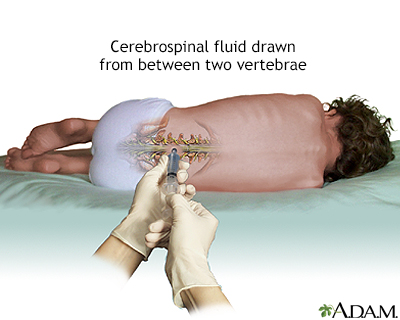CSF glucose test
Glucose test - CSF; Cerebrospinal fluid glucose test
A CSF glucose test measures the amount of sugar (glucose) in the cerebrospinal fluid (CSF). CSF is a clear fluid that flows in the space surrounding the spinal cord and brain.
Images

How the Test is Performed
A sample of CSF is needed. A lumbar puncture, also called a spinal tap, is the most common way to collect this sample.
Other methods for collecting CSF are rarely used, but may be recommended in some cases. They include:
- Cisternal puncture
- Ventricular puncture
- Removal of CSF from a tube that is already in the CSF, such as a shunt or ventricular drain
The sample is sent to a laboratory for testing.
Why the Test is Performed
This test may be done to diagnose:
- Tumors
- Infections
- Inflammation of the central nervous system
- Delirium
- Other neurological and medical conditions
Normal Results
The glucose level in the CSF should be 50 to 80 mg/100 mL or 2.77 to 4.44 mmol/L (or greater than 2/3 of the blood sugar level).
Note: Normal value ranges may vary slightly among different laboratories. Talk to your health care provider about the meaning of your specific test results. Results can also be affected by your serum glucose level, especially if levels are extreme.
The examples above show the common measurements for results for these tests. Some laboratories use different measurements or may test different specimens.
What Abnormal Results Mean
Abnormal results include higher and lower glucose levels. Abnormal results may be due to:
- High blood sugar (hyperglycemia)
- Infection (bacterial or fungus)
- Inflammation of the central nervous system
- Tumor
References
Deluca GC, Griggs RC. Approach to the patient with neurologic disease. In: Goldman L, Schafer AI, eds. Goldman-Cecil Medicine. 26th ed. Philadelphia, PA: Elsevier; 2020:chap 368.
Euerle BD. Spinal puncture and cerebrospinal fluid examination. In: Roberts JR, Custalow CB, Thomsen TW, eds. Roberts and Hedges' Clinical Procedures in Emergency Medicine and Acute Care. 7th ed. Philadelphia, PA: Elsevier; 2019:chap 60.
Rosenberg GA. Brain edema and disorders of cerebrospinal fluid circulation. In: Jankovic J, Mazziotta JC, Pomeroy SL, Newman NJ, eds. Bradley and Daroff's Neurology in Clinical Practice. 8th ed. Philadelphia, PA: Elsevier; 2022:chap 88.
BACK TO TOPReview Date: 4/29/2023
Reviewed By: Joseph V. Campellone, MD, Department of Neurology, Cooper Medical School of Rowan University, Camden, NJ. Review provided by VeriMed Healthcare Network. Also reviewed by David C. Dugdale, MD, Medical Director, Brenda Conaway, Editorial Director, and the A.D.A.M. Editorial team.

Health Content Provider
06/01/2025
|
A.D.A.M., Inc. is accredited by URAC, for Health Content Provider (www.urac.org). URAC's accreditation program is an independent audit to verify that A.D.A.M. follows rigorous standards of quality and accountability. A.D.A.M. is among the first to achieve this important distinction for online health information and services. Learn more about A.D.A.M.'s editorial policy, editorial process and privacy policy. A.D.A.M. is also a founding member of Hi-Ethics. This site complied with the HONcode standard for trustworthy health information from 1995 to 2022, after which HON (Health On the Net, a not-for-profit organization that promoted transparent and reliable health information online) was discontinued. |
The information provided herein should not be used during any medical emergency or for the diagnosis or treatment of any medical condition. A licensed medical professional should be consulted for diagnosis and treatment of any and all medical conditions. Links to other sites are provided for information only -- they do not constitute endorsements of those other sites. © 1997- 2025 A.D.A.M., a business unit of Ebix, Inc. Any duplication or distribution of the information contained herein is strictly prohibited.
